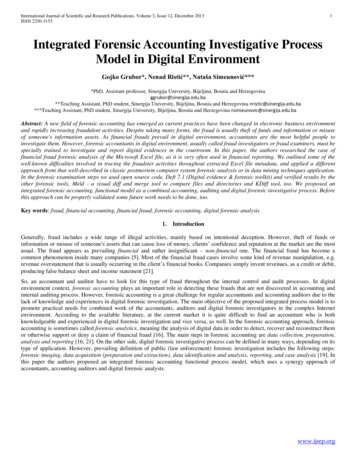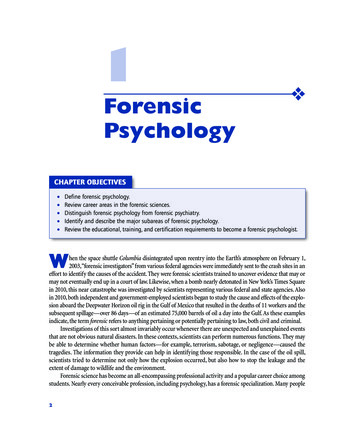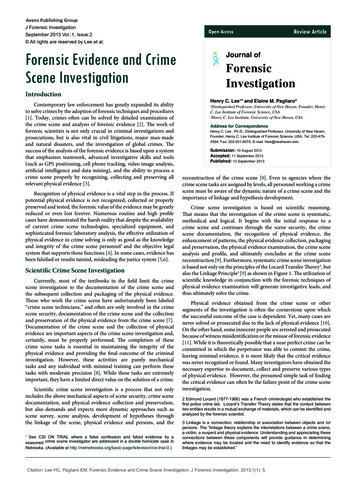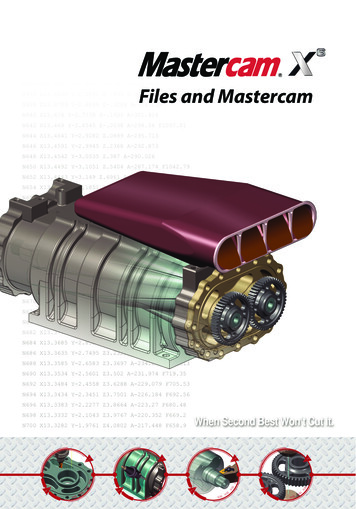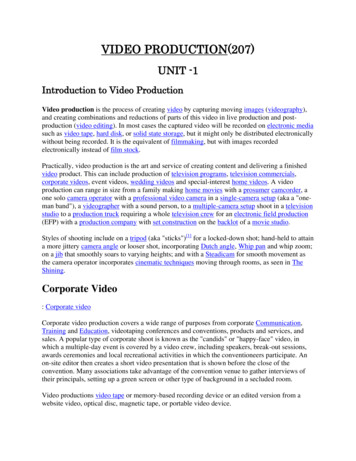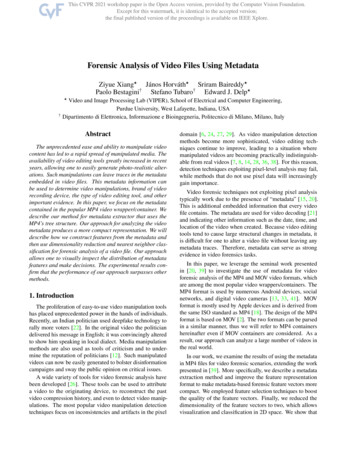
Transcription
Forensic Analysis of Video Files Using MetadataZiyue Xiang János Horváth Sriram Baireddy Paolo Bestagini† Stefano Tubaro† Edward J. Delp Video and Image Processing Lab (VIPER), School of Electrical and Computer Engineering,Purdue University, West Lafayette, Indiana, USA† Dipartimento di Elettronica, Informazione e Bioingegneria, Politecnico di Milano, Milano, ItalyAbstractThe unprecedented ease and ability to manipulate videocontent has led to a rapid spread of manipulated media. Theavailability of video editing tools greatly increased in recentyears, allowing one to easily generate photo-realistic alterations. Such manipulations can leave traces in the metadataembedded in video files. This metadata information canbe used to determine video manipulations, brand of videorecording device, the type of video editing tool, and otherimportant evidence. In this paper, we focus on the metadatacontained in the popular MP4 video wrapper/container. Wedescribe our method for metadata extractor that uses theMP4’s tree structure. Our approach for analyzing the videometadata produces a more compact representation. We willdescribe how we construct features from the metadata andthen use dimensionality reduction and nearest neighbor classification for forensic analysis of a video file. Our approachallows one to visually inspect the distribution of metadatafeatures and make decisions. The experimental results confirm that the performance of our approach surpasses othermethods.1. IntroductionThe proliferation of easy-to-use video manipulation toolshas placed unprecedented power in the hands of individuals.Recently, an Indian politician used deepfake technology torally more voters [22]. In the original video the politiciandelivered his message in English; it was convincingly alteredto show him speaking in local dialect. Media manipulationmethods are also used as tools of criticism and to undermine the reputation of politicians [12]. Such manipulatedvideos can now be easily generated to bolster disinformationcampaigns and sway the public opinion on critical issues.A wide variety of tools for video forensic analysis havebeen developed [26]. These tools can be used to attributea video to the originating device, to reconstruct the pastvideo compression history, and even to detect video manipulations. The most popular video manipulation detectiontechniques focus on inconsistencies and artifacts in the pixeldomain [6, 24, 27, 29]. As video manipulation detectionmethods become more sophisticated, video editing techniques continue to improve, leading to a situation wheremanipulated videos are becoming practically indistinguishable from real videos [7, 8, 14, 28, 36, 38]. For this reason,detection techniques exploiting pixel-level analysis may fail,while methods that do not use pixel data will increasinglygain importance.Video forensic techniques not exploiting pixel analysistypically work due to the presence of “metadata” [15, 20].This is additional embedded information that every videofile contains. The metadata are used for video decoding [21]and indicating other information such as the date, time, andlocation of the video when created. Because video editingtools tend to cause large structural changes in metadata, itis difficult for one to alter a video file without leaving anymetadata traces. Therefore, metadata can serve as strongevidence in video forensics tasks.In this paper, we leverage the seminal work presentedin [20, 39] to investigate the use of metadata for videoforensic analysis of the MP4 and MOV video formats, whichare among the most popular video wrappers/containers. TheMP4 format is used by numerous Android devices, socialnetworks, and digital video cameras [13, 33, 41]. MOVformat is mostly used by Apple devices and is derived fromthe same ISO standard as MP4 [18]. The design of the MP4format is based on MOV [2]. The two formats can be parsedin a similar manner, thus we will refer to MP4 containershereinafter even if MOV containers are considered. As aresult, our approach can analyze a large number of videos inthe real world.In our work, we examine the results of using the metadatain MP4 files for video forensic scenarios, extending the workpresented in [39]. More specifically, we describe a metadataextraction method and improve the feature representationformat to make metadata-based forensic feature vectors morecompact. We employed feature selection techniques to boostthe quality of the feature vectors. Finally, we reduced thedimensionality of the feature vectors to two, which allowsvisualization and classification in 2D space. We show that
these feature vectors can be used for a wide variety of videoforensic tasks, from source attribution to tampering detection.Compared to other work, our proposed approach can generate2D feature scatter plots and decision boundary graphs formany video forensics tasks. This feature enables us to gaininsights into the distribution of MP4 metadata and makeinterpretable decisions.Our experimental results show that many video forensicsproblems on standard datasets can be solved reliably bylooking only at metadata. We also discovered that videosuploaded to specific social networks (e.g., TikTok, WeiBo)present altered metadata, which invalidates metadata-basedforensics methods. This is one of the limitations of ourtechniques and will be addressed in future research.2. Related WorkMany techniques have been described to determinewhether some part of a video has been tampered or not [26].Most of these methods were developed to detect manipulations in the pixel domain and do not use metadata information.Compared to pixel-level analysis, metadata-based methodspossess unique advantages. The size of metadata is significantly smaller than pixel data, which enables the analysisof large datasets in short amounts of time. Most videomanipulation software do not allow users to alter metadatadirectly [15, 20]. Consequently, metadata has a higher degree of opacity than pixel data, which makes metadata-basedmedia forensics more reliable and its corresponding attacksmore challenging.Most existing work focuses on the metadata in MP4-likevideo containers, which maintain data in a tree structure. In[20] and [39], the authors design features based on symbolicrepresentation of MP4’s tree structure, which are processedby a statistical decision framework and decision trees, respectively. The authors report high performance for both videoauthentication and attribution tasks. Güera et al. [15] extractvideo metadata with the ffprobe utility and then do videoauthentication with an ensemble classifier.More low-level metadata-related information can be foundby looking into video compression traces. Video compressionmethods typically leave series of traces related to the waythe video frames are compressed. This information is noteasy to modify, thus acting as a metadata-like feature. As anexample, most contemporary video encoders compress framesequences in a structures known as a Group of Pictures (GOP),where one frame can be defined using contents of other framesin order to save space [30]. The dependency between frameswithin or across different GOPs may provide evidence forvideo manipulation. Due to the complexity of video codecs,a number of techniques have been proposed for varioussettings of a codec where specific video encoding featuresare turned on or off. Vázquez-Padín et al. [37] provide adetailed explanation of the video encoding process and GOPComprehensive Video Metadata ExtractionMetadatatreeparsingudtarefining1Vector representationof metadata tree2metauuidrefiningrefining3Feature selectionDimensionality reduction and classification4BrandattributionManipulationtool ondetectionFigure 1: The structure of our proposed metadata forensic analysistechnique.structure. They propose a video authentication method thatgeneralizes across multiple video encoding settings. Yao etal. [40] discuss the detection of double compression whenan advanced video encoding feature called adaptive GOP isenabled.3. Proposed Approach3.1. An Overview of Our ApproachVideo metadata captures multiple aspects of the historyof a video file. In this paper we propose a framework thatexploits an MP4 video file’s metadata to solve multiplevideo forensics problems, including brand attribution, videoediting tool identification, social network attribution, andmanipulation detection. Our method can also be easilyadapted to other forensics applications.The structure of our proposed framework is illustrated inFigure 1. As will be discussed in Section 3.2, the MP4 formatmanages data using a tree structure. First we extract themetadata from MP4 files while preserving their relationshipsin the tree structure. The MP4 standard is around twentyyears old, it contains numerous vendor-specific nuances thatrequire separate parsing strategies. The metadata tree needsto go through several refining stages, which increase thegranularity of the extracted information. In the next step, thetree representation of metadata is converted into a numericfeature vector, which can be easily processed by machinelearning methods. Our feature representation scheme is basedupon [39]. We improve the handling of media tracks andmetadata fields that take on continuous values inside the tree.The resulting feature vectors preserve more characteristicsof the videos, yet they tend to also be more compact. Inthe last stage, we use these features with a classifier basedon the selected forensic application. In the following weprovide additional details about each step of our proposedframework.
STRING 1moovx00 x00 x50 x2CMP4 filex00 x6Cmvmoohd.vMEANINGx00 x00The moov box is present in MP4 file.moovboxSTRING 2moov/mvhdMEANINGThe mvhd box is present in MP4 file. It is a child box of moov.One can also imply that the moov node itself must not containany binary data.Figure 2: Illustration of the MP4 file format, where each cellrepresents one byte. An MP4 file is made up of a series of boxes.Every box has an 8-byte header, where the first 4 bytes store thesize of the box in bytes (including the header) as a 32-bit big-endianinteger, and the last 4 bytes store the name of the box. The contentof a box is either child boxes or binary data. Binary data fromdifferent boxes may require distinct decoding methods.STRING 3moov/mvhd/@duration 1546737MEANINGThe mvhd box is a leaf node in the tree; it contains a field calledduration, whose value is 1546737.STRING 4moov/udta/@ A9 mod 00 09 & 81 iPhone 5cMEANINGThe udta box is a leaf node in the tree; it contains a field calledA9 mod, whose value is 00 09 & 81 iPhone 5c.3.2. Video MetadataThe first step in our approach consists of parsing metadatafrom video files. Digital video files are designed to handlemultimodal data such as video, audio, and subtitles. Thestandards of these data modalities also shifts as technologyadvances. For example, since MP4’s introduction in 2001,the mainstream video codec has changed from MPEG-2to H.264, and may change to H.265 in the near future[17, 34, 35]. The metadata surrounding these various datamodalities and standards are inserted into a video file indistinct ways. In this paper, we use the word comprehensiveto describe a video metadata extraction scheme that is capableof parsing metadata across most data modalities and encodingspecifications.Figure 2 shows the basic structure of an MP4 file [19].An MP4 file is composed by a number of boxes. Each boxstarts with a header that specifies the box size (in byte) andname. The size helps the user to locate box boundaries,and the name defines the purpose of the box. The contentof a box can either be a child box or some encoded binarydata. Thus, an MP4 file is effectively a tree structure, whereinformation is stored on leaf nodes. Given MP4’s treestructure, we can capture metadata information at two levels:(1) the structure of the tree; and (2) the interpreted valuesof binary data contained in leaf nodes. Therefore, the jobof a metadata extractor is to traverse the MP4 tree, attainthe tree’s structure, filter non-metadata leaf nodes (e.g.,nodes that contain video compressed pixel information) andinterpret values on relevant leaves. As shown in Figure 3, theoutput of a metadata extractor can be represented withoutany loss by a collection of human-readable strings.Our metadata extractor focuses on vendor-specific nonstandard MP4 metadata boxes that are significant for forensicpurposes. More precisely, we determine that udta, uuid,meta, and ilst boxes are likely to carry vital information forvideo forensics. We next discuss our strategies to refine theparsing process.Figure 3: Examples of representing MP4 metadata tree with strings.Node paths are separated with ‘/’, the values of leaf nodes areprefixed with ‘@’, non-ASCII and unprintable characters are shownas hexadecimal codes surrounded by black frames. The metadatatree of any MP4 file can be portrayed by a collection of such strings.3.2.1Parsing ilst Data(“metadata item list”) boxes in MP4 files are used tostore vendor-specific metadata [3]. Generally speaking, ilstboxes are container boxes whose child boxes carry metadataitems as key-value pairs. The names of ilst’s children (i.e.,the keys) would start with A9 (equivalent to character ‘ ’). Alist of frequently used ilst keys is shown in Table 1. One cansee that the content of the ilst box is particularly importantfor forensic analysis, for it often contains information aboutthe manufacturer of the video capturing device, the encoderversion, and the location and time of the capture.It is difficult to parse the ilst box because various devicemanufacturers employ vastly different approaches when usingit. Below, we report some interesting variants we foundduring our experiments:ilst ilst’s child boxes directly placed in moov/udtaIn some old Apple devices (e.g., iPhone 4, iPhone 5c,iPad 2), the child boxes of ilst are placed directly inmoov/udta box. ilst boxes in moov/metaAs its name suggests, the meta box is used to store metadata.Table 1: A list of common keys in ilst boxes [4].KeyDescriptionA9 modA9 tooA9 namA9 swrA9 swfA9 dayA9 xyzcamera modelname and version of encoding tooltitle of the contentname and version number of creation softwarename of creatortimestamp of the videogeographic location of the video
In this case, the meta box behaves similarly as otherstandard boxes, which means it can be parsed normally.As the MP4 parser traverses the box, it will eventuallyreach ilst and its children. ilst boxes in moov/udta/meta and moov/trak/metaWhen meta boxes appear in udta and trak boxes, theydeviate from standard boxes. More specifically, 4 extrabytes are inserted right after the meta header to storeinformation [25]. These types of meta boxes cannot beparsed by the MP4 parser, normally because the programwill see these 4 bytes as the size of next box, which willlead to corrupted results.Our comprehensive metadata extractor is able to distinguish between these three scenarios and process MP4 videofiles correctly by fine-tuning the parsing of udta and metaboxes.3.2.2Parsing XML DataWe concluded that many video files contain XML data afterinspecting numerous video files, especially those edited byExifTool and Adobe Premiere Pro. These tools make useof the Extensible Metadata Platform (XMP) to enhancemetadata management, which introduces a large amount ofmetadata inside an MP4 file’s uuid and udta boxes in theform of XML. In Figure 4, we show two XML examplesextracted from MP4 containers. It can be seen that these XMLdata can potentially contain a large amount of information,which includes type of manipulation, original value beforemanipulation, and even traces to locate the person that appliedthe manipulation. It is vital for our metadata extractor tohave the ability to handle XML data inside MP4 files.To avoid over-complicating the extracted metadata tree,we discard the tree structure of XML elements and flattenthem into a collection of key-value pairs. If there is a collisionbetween key names, the older value will be overwritten bythe newer one, which indicates that only the last occurringvalue of each key is preserved. Despite the fact that someinformation is lost by doing so, the data we have extractedis likely to be more than enough for most automated videoforensic applications.3.3. Track and Type Aware FeatureThe second step of our approach consists of turning theparsed metadata into feature vectors. Most machine learningmethods use vectors as the input. The string representationof metadata trees generated in the previous step needs tobe transformed into feature vectors before being used bymachine learning methods.Our feature representation technique is shown in Figure5. For feature vectors to contain sufficient information ofthe MP4 tree, they need to include two levels of details:structure of the tree and value of metadata fields. Metadatacan be either categorical or continuous numerical fields.Considering categorical values, we assign each node andmetadata key-value pair in the MP4 tree an element in thefeature vector, which counts the number of occurrencesof that node or pair. This strategy preserves informationabout the MP4 tree in the feature vector to a great extent.Considering numerical values, creating a new element foreach of these key-value pairs will render the feature vectorslarge and redundant. We decide to insert the values into thefeature vectors directly.From Figure 3, we know that string representation can beput into two categories: (1) strings that indicate the presenceof a node, with node path separated by ‘/ ’; and (2) stringsthat show the key-value pair stored in a node, with nodepath separated by ‘/ ’ and key-value separated by ‘ ’. Sincean MP4 file can be seen as a collection of such strings, thefeature transformation process can be viewed as a mappingfrom a given collection of strings 𝑆 to a vector 𝒗. For thediscussion below, we use 𝒗 [𝑙] to denote the 𝑙-th element of 𝒗.In order to construct a mapping 𝑆 𝒗, we need toconsider the set of all possible strings Ω. We denote the setof all category (1) strings and category (2) strings by 𝐶 (1)and 𝐶 (2) , respectively. By definition, 𝐶 (1) and 𝐶 (2) forma partition of Ω. We assume that both 𝐶 (1) and 𝐶 (2) areordered so that we can query each element by its index. Letus denote the 𝑙-th elements of 𝐶 (1) and 𝐶 (2) by 𝐶 (1) [𝑙] and𝐶 (2) [𝑙], respectively.Each category (1) string corresponds to an element in 𝒗.For the 𝑖-th category (1) string, we denote the index of thecorresponding vector element in 𝒗 by 𝜒 (1) (𝑖). The valuecorresponding to this element is given by𝒗 [ 𝜒 (1) (𝑖) ] number of times 𝐶 (1) [𝑖] occurrs in 𝑆, 𝑖 1, 2, . . . , 𝐶 (1) . (1)We treat each media track (trak) segment in the metadatastrings in a different way. In the MP4 file format, each traknode contains information about an individual track managedby the file container. We observed that the number of tracksand content of the tracks remain consistent among devicesof the same model. The structure of an MP4 file can bebetter preserved if we distinguish different tracks rather thanmerging them. This is achieved by assigning each track atrack number in the metadata extraction phase. For example,the first track will be moov/trak1, and the second track willbe moov/trak2. As a result, the child nodes and key-valuepairs of each track will be separated, which effectively makesthe feature vectors track-aware.For category (2) strings that represent key-value pairsstored in a node, we applied a slightly different transformationstrategy. We observed that some fields in MP4 files areessentially continuous (e.g., @avgBitrate, @width). Despitethe fact that most MP4 metadata fields are discrete, assigningeach combination of these continuous key-value pairs a new
x:xmpmeta xmlns:x 3D"adobe:ns:meta/" x:xmptk 3D"Adobe XMP Core5.6-c145 79 .163499, 2018/08/13-16:40:22" rdf:RDF xmlns:rdf 3D"http://www.w3.org/1999/02/22-rdf-syntax-ns#" rdf:Description rdf:about 3D""xmp:CreateDate 3D"2019-11-19T22:47:45 01:00"xmp:ModifyDate 3D"2019-11-19T22:47:45 01:00"xmp:MetadataDate 3D"2019-11-19T22:47:45 01:00"xmp:CreatorTool 3D"Adobe Premiere Pro CC 2019.0 (Windows)"dc:format 3D"H.264" creatorAtom:windowsAtomcreatorAtom:extension 3D".prproj"creatorAtom:invocationFlags 3D"/L"creatorAtom:uncProjectPath 3D"\\?\C:\Users\pengpeng\Documents\Ado ⌋ be\Pre miere Pro\13.0\premcut.prproj"/ /rdf:RDF /x:xmpmeta (a) Excerpt of XML data from a video processed by Adobe PremierePro. It clearly contains multiple important timestamps, the softwarename and version, and even the path to the Premiere project. x:xmpmeta xmlns:x 3D'adobe:ns:meta/' x:xmptk 3D'Image::ExifTool11.37' rdf:RDF xmlns:rdf 3D'http://www.w3.org/1999/02/22-rdf-syntax-ns#' rdf:Description rdf:about 3D''xmlns:exif 3D'http://ns.adobe.com/exif/1.0/' exif:DateTimeOriginal 1986-11-05T12:00:00 /exif:DateTimeOriginal /rdf:Description rdf:Description rdf:about 3D''xmlns:xmp 3D'http://ns.adobe.com/xap/1.0/' xmp:CreateDate 1986-11-05T12:00:00 /xmp:CreateDate xmp:ModifyDate 1986-11-05T12:00:00 /xmp:ModifyDate /rdf:Description /rdf:RDF /x:xmpmeta (b) XML data from a video modified by ExifTool. It can beseen that the version of ExifTool is 11.37; the presence of exif:DateTimeOriginal implies the date of the video is modified.Figure 4: Examples of XML data in MP4 video containers.number of occurrences of nodes···moov/trak/tkhd/@width 600.0form a valid partition of integers in the range [1, dim(𝒗)].By using different representation strategies for discreteand continuous fields (i.e., being type-aware), the resultingfeature vectors are more compact and suited to machinelearning techniques.value of continuous metadatafields3.4. Feature Selection𝜒 (1) (𝑖)moov/mvhdmoov/mvhdmoov/mvhd0 21 3 0600moov/trak/tkhd/@track ID 1moov/trak/tkhd/@track ID 1number of occurrences ofcategorical metadata fields1···𝜒 𝑐′ (𝑘)(2)𝜒 𝑑 ( 𝑗)(2)Figure 5: Illustration of the vector representation of MP4 metadata.The 𝜒 functions help determine the corresponding element of anode or a metadata field in the feature vector.element in 𝒗 will still result in large and redundant featurevectors. We continue to subdivide 𝐶 (2) based on the type ofeach field, where the set of strings that have discrete fields is𝑑denoted by 𝐶 (2), and the set of strings that have continuous𝑐 . For strings that belong to 𝐶 𝑑 ,fields is denoted by 𝐶 (2)(2)the transformation scheme is similar to that of category (1)strings. Let the vector element index of the 𝑗-th string in𝑑𝐶 (2)be 𝜒 𝑑(2) ( 𝑗), then the value corresponding to the elementis given by𝒗 h 𝜒𝑑(2) ( 𝑗)i𝑑 number of times 𝐶 (2)[ 𝑗] occurs in 𝑆,on𝑑. 𝑗 1, 2, . . . , 𝐶 (2)As for strings that belong to𝑐 ,𝐶 (2)(2)we first discard the values′𝑐 , and then putin the strings to form a set of distinct keys 𝐶 (2)′𝑐 , the indexthe values in 𝒗 directly. For the 𝑘-th string in 𝐶 (2)′of the corresponding vector element in 𝒗 is 𝜒 𝑐(2) ( 𝑗), and thevalue of the elementis(𝑐′ [𝑘] in 𝑆the value of key 𝐶 (2)ih𝒗 𝜒 𝑐′ (𝑘) ,𝑐′ [𝑘] is not in 𝑆)(2)0 (if the key 𝐶 (2)no𝑐′ 𝑗 1, 2, . . . , 𝐶 (2). (3)It can be seen that the dimensionality of 𝒗 is given by𝑑𝑐′dim(𝒗) 𝐶 (1) 𝐶 (2) 𝐶 (2).(4)In general, the actual value of the index functions 𝜒 can be′arbitrary as long as all values of 𝜒 (1) (𝑖), 𝜒 𝑑(2) ( 𝑗), and 𝜒 𝑐(2) (𝑘)Our third step consists of reducing the set of selectedfeatures by discarding redundant features. Based on thefeature extraction scheme above, it can be observed that someelements in the feature vector are significantly correlated.For example, the presence of string moov/mvhd/@duration 1546737 in a collection 𝑆 extracted from a valid MP4 filemust lead to the presence of moov/mvhd in 𝑆. Therefore,feature selection can reduce redundancy within the featurevectors.In the feature selection step, we reduce the redundancyamong features that are strongly correlated. Since only asmall proportion of elements in the feature vector 𝒗 are inserted from continuous fields, most elements in 𝒗 correspondto the number of occurrences of a node or a field value.If two features in 𝒗 are negatively correlated, then it oftenmeans the presence of an MP4 entity implies the absence ofanother MP4 entity. In forensic scenarios, presence is muchstronger evidence than absence. Therefore, if we only focuson features that are positively correlated, then we can selectfeatures of higher forensic significance.Given a set of feature vectors 𝒗 1 , 𝒗 2 , . . . , 𝒗 𝑁 , we cancompute the corresponding correlation matrix 𝑹, where 𝑹𝑖 𝑗is equal to the correlation coefficient between 𝑖-th and 𝑗-thfeature in the set. Then, we set all negative elements in𝑹 to zero, which results in matrix 𝑹 . That is, negativecorrelation is ignored. Because all elements in 𝑹 are withinthe range [0, 1], the matrix 𝑹 can be seen as an affinitymatrix between dim(𝒗) vertices in a graph, where an affinityvalue of 0 indicates no connection and an affinity valueof 0 indicates strongest connection. This allow us to usespectral clustering with 𝛼 clusters on 𝑹 , which assignsmultiple strongly correlated features into the same cluster[31]. Then, we select clusters with more than 𝛽 features. For
each selected cluster, we retain only one feature at random.Here, 𝛼 𝛽 0 are hyperparameters. This feature selectionstep helps improve the quality of feature vectors.3.5. Dimensionality Reduction and ClassificationIn the last step, depending on the the video forensicsproblem, we use the feature vectors for classification in twoways.Multi-class problems When the classification problem ismulti-class, we use linear discriminant analysis (LDA) [11]to drastically reduce the dimensionality of feature vectors to2 dimensions. LDA is a supervised dimensionality reductiontechnique. For a classification problem of 𝐾 classes, LDAgenerates an optimal feature representation in a subspace thathas dimensionality of at most 𝐾 1. The new features in thesubspace are optimal in the sense that the variance betweenprojected class centroids are maximized. For multi-classclassification problems, we always reduce the dimensionalityof the feature vector to 2. After dimensionality reduction,we use a nearest neighbor classifier that uses the distancebetween the query sample and 𝜆 nearest samples to make adecision, where 𝜆 is a hyperparameter. Each nearest sampleis weighted by their distance to the query sample. The use ofthe dimensionality reduction and nearest neighbor classifierlead to concise and straightforward decision rules in 2Dspace, which can be interpreted and analyzed by humanexperts easily.Two-class problems When the classification problem istwo-class (𝐾 2), LDA can only generate one-dimensionalfeatures. Our experiments have shown that 1D features areinsufficient to represent the underlying complexity of videoforensics problems. As a result, for binary classification problems, we use a decision tree classifier without dimensionalityreduction.4. Experiments and ResultsIn this section we report all the details of the experimentsand comment on the results.We study the effectiveness of our approach using thefollowing datasets: VISION [32]: the VISION dataset contains 629 pristineMP4/MOV videos captured by 35 different Apple, Androidand Microsoft mobile devices. EVA-7K [39]: the EVA-7K dataset contains approximately7000 videos captured by various mobile devices, uploadedto distinct social networks, and edited by different videomanipulation tools. The authors took a subset of videosfrom the VISION dataset and edited them with a numberof video editing tools. Then, they uploaded both theoriginal videos and edited videos to four social networks,namely YouTube, Facebook, TikTok and WeiBo. Thevideos were subsequently downloaded back. The EVA-7Kdataset is made up of the pristine videos, edited videos,and downloaded videos.The VISION dataset is used for device attribution experiments, while all other experiments are conducted on thelarger EVA-7K dataset.We demonstrate the effectiveness of our approach infour video forensic scenarios. In all of the experimentsbelow that use LDA and nearest neighbor classification,we choose 𝛼 300, 𝛽 4, and 𝜆 5. For each of thescenarios below, unless indicated otherwise, the dataset issplit into two halves with stratified sampling for training andvalidation, respectively. The metadata nodes and fields thatare excluded during metadata extraction, as well as the listof continuous features in the vector representation step, areprovided in supplementary materials. We mainly comparethe performance of our method to [39], where the EVA-7Kdataset is described. For brand attribution, because it isconducted on the VISION dataset, we select [20] as thebaseline. The experiment results show that our approachachieves high performance evaluation metrics in all fourscenarios.4.1. Scenario 1: Brand AttributionBrand attribution consists of identifying the brand of thedevice used to capture the video file under analysis. Weexamined brand attribution experiments in two scenarios. Inthe first experiment, we assume the analyst has access to allpossible devices at training time (i.e., close-set scenario). Inthe second experiment, we assume that a specific device maybe unknown at training time (i.e., blind scenario).Close-set scenario In Table 2, we show the F1-score comparison between our approach and previous work. Ourmethod almost perfectly classifies the VISION dataset, withonly one Apple device being misclassified as Samsung. Because our framework is capable of extracting and analyzingmore metadata, the performance of our method is bettercompared to the baseline, especially for brands like Huawei,LG, and Xiaomi. The 2D feature distribution and decisionboundary for each label are shown in Figure 6, from whichwe can determine the metadata similarity between brandsand the metadata “variance” for each brand. Visualizationsas shown in Figure 6 generated by our method can aid ananalyst in making a more interpretable and reliable decision.If a new video under examination is
a video to the originating device to reconstruct the past video compression history, and even to detect video manip ulations The most popular video manipulation detection techniques focus on inconsistencies and artifacts in the pixel domain [6, 4 , 27, 29]. s video manipulation detection methods beco




